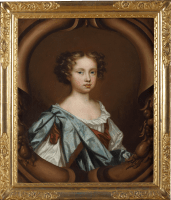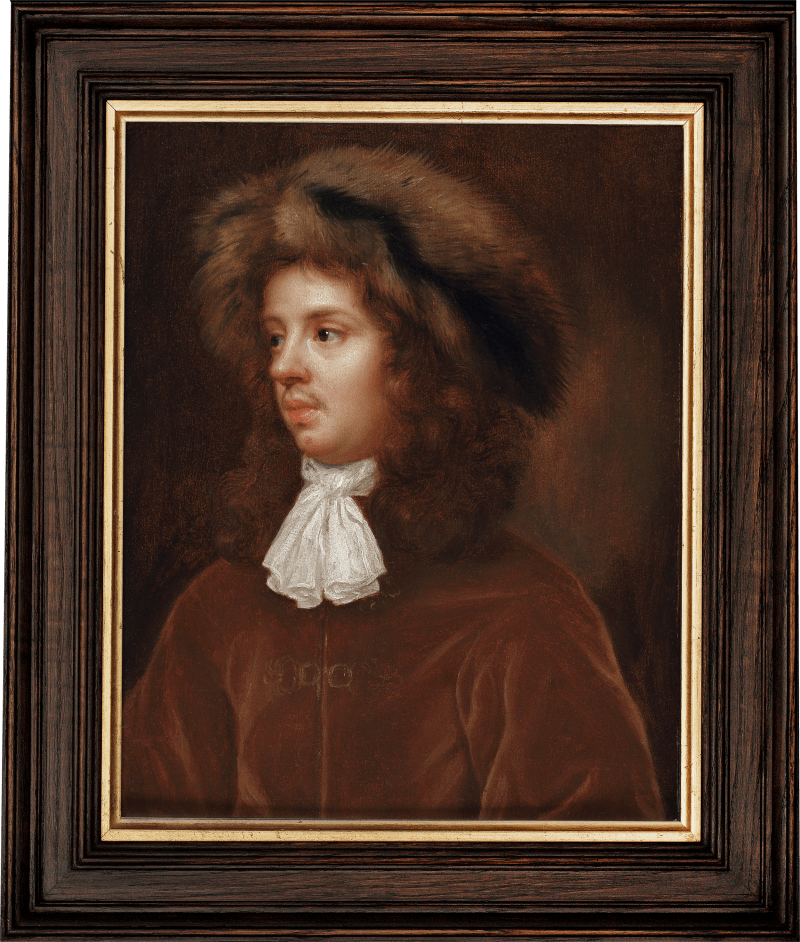This portrait of a young girl was painted around 1680 and is notable for its empathetic portrayal of the sitter’s youthfulness. There was often a tension in child portraiture at this date between the formality of adulthood and the informality of youth. Beale’s ability to successfully strike this balance was perhaps due to the numerous studies of her children she painted for ‘study and improvement’; as portrayals of youth, they are almost unparalleled in portraiture from this period.
The young sitter is shown in a style of costume favoured by society portraitists at this date: it is classically inspired with a timeless quality that appealed to sitters wary of ever-changing fashions. The blue drape worn over the shoulder was painted using ultramarine, a costly pigment for which Beale charged an additional fee of £1 on top of her standard £5 for a three-quarter portrait on this scale at this date.[1]
The ornate painted cartouche that frames the young sitter can...
This portrait of a young girl was painted around 1680 and is notable for its empathetic portrayal of the sitter’s youthfulness. There was often a tension in child portraiture at this date between the formality of adulthood and the informality of youth. Beale’s ability to successfully strike this balance was perhaps due to the numerous studies of her children she painted for ‘study and improvement’; as portrayals of youth, they are almost unparalleled in portraiture from this period.
The young sitter is shown in a style of costume favoured by society portraitists at this date: it is classically inspired with a timeless quality that appealed to sitters wary of ever-changing fashions. The blue drape worn over the shoulder was painted using ultramarine, a costly pigment for which Beale charged an additional fee of £1 on top of her standard £5 for a three-quarter portrait on this scale at this date.[1]
The ornate painted cartouche that frames the young sitter can be found in numerous works by Beale from this period, including the Portrait of a Gentleman included in this exhibition. We know that Beale’s sons, Bartholomew and Charles, were employed to paint decorative trompe-l’œil borders and draperies and may well have assisted in the painting of this particular portrait.
While still in Beale’s studio, perhaps even before it was completed, her son Charles copied the present work in red chalks. The drawing forms part of a remarkable collection of sketches by him produced around 1679–80, preserved across two sketchbooks and 175 individual sheets.[2] The collection includes quick, informal portraits of the Beale household members and detailed studies of finished portraits. It may be that Charles copied the portrait when only the head and shoulders had been completed and before the costume was added.
[1] Draper 2020, p.208.
[2] The sketchbooks and loose drawings are in the following collections: ‘1st Book, 1679’, Pierpont Morgan Library, New York; ‘3rd Book 1680’, British Museum, London; 175 separately mounted sheets that may originally have formed a further sketchbook, The British Museum. Replicas of sixty drawings in the ‘3rd Book’ are in a so-called ‘fourth’ book acquired by the British Museum in 1681, but the attribution to Charles has been questioned. See Stainton and White 1987, cat. 170.













